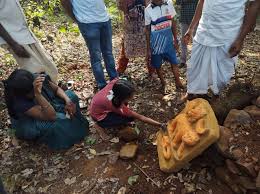Sacred Groves

- 08 Dec 2024
In News:
Preserving India’s sacred groves can help country achieve its conservation & climate goals.
Sacred Groves in India:
- Sacred groves are forest patches that are culturally and spiritually important for various communities.
- They are known by different names across India: sarnas in Jharkhand, devgudis in Chhattisgarh, and orans in Rajasthan.
- Groves vary in size from small clusters of trees to expansive forests covering several acres.
Threats to Sacred Groves:
- Sacred groves are increasingly under threat due to deforestation, mining, and development activities.
- Many sacred groves are being displaced or degraded, putting biodiversity and cultural practices at risk.
Ecological and Cultural Importance:
- Sacred groves are rich in biodiversity and serve as important carbon sinks, contributing to climate change mitigation.
- They have been maintained by indigenous communities for centuries, creating a deep connection between people and nature.
- Sacred groves also play a crucial role in preserving indigenous spiritual practices and cultural heritage.
Contribution to Climate and Conservation Goals:
- India’s climate commitment of achieving net-zero emissions by 2070 requires the protection of forests, including sacred groves.
- Sacred groves, when properly managed, can help in carbon sequestration and climate change mitigation.
- Preserving these groves can support forest conservation and foster coexistence with wildlife, ensuring a balance between development and environmental preservation.
Role of Indigenous Communities:
- Indigenous communities have long used sacred groves to regulate the use of forest resources and ensure environmental sustainability.
- Before modern ecological concepts, sacred groves were seen as natural conservation practices guided by spiritual beliefs.
- This traditional wisdom can be leveraged to enhance conservation efforts in India.
Examples of Successful Sacred Grove Conservation:
- Waghoba Grove in Maharashtra:
- Located in Chinchwadi village, the Taata chi Vanrai grove is dedicated to Waghoba, the tiger deity, and covers eight acres.
- Local communities, including the Thakars, have successfully resisted illegal timber extraction and helped conserve the grove, witnessing the return of wildlife like leopards.
- Worship of Waghoba has played a significant role in preserving forest patches and fostering human-animal coexistence.
- Tadoba-Andhari Tiger Reserve:
- Sacred groves around the Tadoba Reserve, dedicated to Waghoba, are important in reducing human-wildlife conflicts by promoting spiritual ties with the forest.
Government and Community Efforts:
- The Jharkhand government introduced the concept of gherabandi (boundary walls) in 2019 to conserve sacred groves.
- In Chhattisgarh, the renovation of sacred groves has been undertaken to protect and restore these areas.
- Despite these efforts, challenges remain in involving local communities and integrating sacred groves into broader conservation policies.
The Role of OECMs in Sacred Grove Conservation:
- Sacred groves are considered part of Other Effective Area-Based Conservation Measures (OECMs), which are areas conserved for biodiversity outside protected regions.
- OECMs recognize the cultural, spiritual, and socio-economic value of these areas and promote sustainable conservation practices that benefit both biodiversity and local communities.
- Sacred groves play an essential role in achieving long-term biodiversity conservation and ecosystem services.
